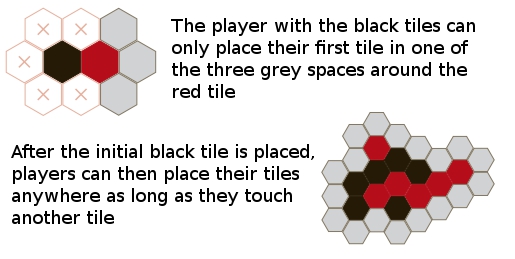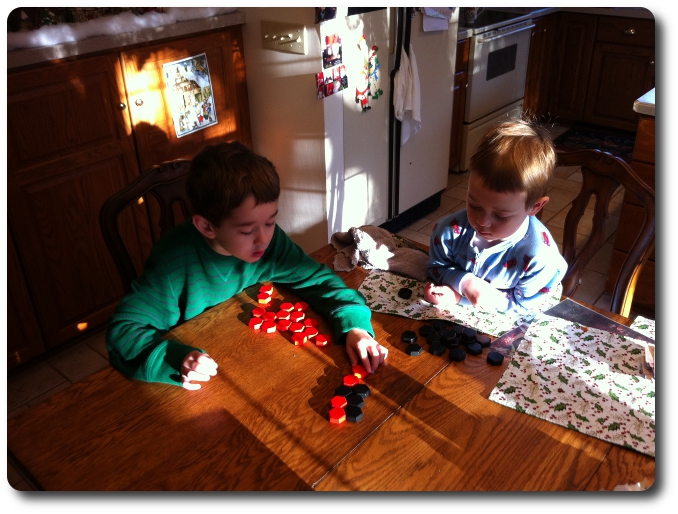
The Basics:
- For ages 4 and up (publisher suggests 7+)
- For 2 or 4 players (teams)
- About 10 minutes to complete
Geek Skills:
- Counting & Math
- Logical & Critical Decision Making
- Pattern/Color Matching
- Strategy & Tactics
- Visuospatial Skills
- Cooperative & Team Play
Learning Curve:
- Child – Easy
- Adult – Easy
Theme & Narrative:
- None
Endorsements:
- Gamer Geek approved!
- Parent Geek approved!
- Child Geek approved!
Overview
At first, it looks to be a simple exercise in tedious hexagon placement again and again until a simple shape is created. A ho-hum affair with little to provide in the way of entertainment or challenge. A hexagon here, a hexagon there, and you are suddenly very aware that you are close to loosing! How did this happen? Without even a hint of change, the game turns into a battle of wits as you attempt to out maneuver and out play your opponent in an ever shifting game where you are ahead one moment and then greatly behind the next!
Six is comprised of 42 thick wooden hexagon tiles, 21 of which are black and the other 21 are red. The box the game comes in is nice but will most likely be replaced by the cloth bag that is also included. All the hexagons and the rules fit very nicely in the bag which makes the game exceedingly easy to pack up and take with you on trips.
Game Set Up
The initial game set up is the same for a 2-player game and a 4-player game. Separate the two different colored hexagons, for a total of 20 black and 20 red hexagons. The two remaining hexagons (1 black and 1 red) are placed end-to-end in the middle of the playing area to begin the game.
How the game is now played is based on how many geeks you have at the table.
One On One
For the 2-player game, each player will take turns placing one of their hexagons in the playing area in an attempt to be the first to create one of three possible shapes. In order to do so correctly, the players must place their hexagons so they are also touching another hexagon already in play, regardless of color, along the long edges of the hexagons. Other than that, there is no other rule in regards to placement except for the opening move.

The three shapes the players are attempting to be the first to build
The opening move, given to the player with the black hexagons, is the only hexagon placement action that has an additional rule. The initial hexagon placement for the black hexagon must be touching one of the edges of the red hexagon , but not touching any edge of the black hexagon. After this initial placement, players no longer have any restrictions and can place their hexagons edge-to-edge regardless of color anywhere in the playing area.

If all 42 hexagons have been placed without a player completing one of the three shapes, players then take turns removing one hexagon at a time on their turn and placing it in another location. Players are welcome to take any hexagon they want, but by doing so can never break the collection of hexagons into two different groups. Put another way, the players must always be working on one large cluster of hexagons and cannot break that cluster into two or more parts.
Team Play
In a 4-player game, team members sit opposite of each other. Each team member takes 10 hexagons of their team’s color. Play is the same as a 2-player game. One of the players on the black team goes first, followed by a red team member and then a black team member and so on in a clockwise direction. The only special rule is that the team members cannot give each other verbal or physical clues or ques in regards to where hexagons should be placed. That means no groans, grunts, pointing, or rolling of eyes.
Winning the Game
The first player or team to build one of the three shapes wins the game. If a shape is built and goes unnoticed, it can be recognized in the following turns.
Advanced Play
The game comes with advanced rules that are not used until all the players have placed their 42 hexagons. Once that condition is met, the following rules are applied:
- The cluster can be broken into two pieces. The smaller of the two clusters, and all hexagons it is comprised of, is removed from play for the duration of the game.
- If the two clusters have an equal number of hexagons, the player who broke the cluster into two decides which is kept.
- If at any time a player/team is left with only 5 or less hexagons, they have lost the game.
- If both players/teams are left with 5 or less simultaneously, the game is a draw.
To learn more about the game and read the full rules, visit the game’s official web site.
Note: the directions provided online are slightly different from the ones provided with the game – for example, the online PDF rules suggest that the game is only comprised of 38 wooden hexagons instead of 42.
Prediction
Puzzle games appear to be all the rage for my little geeks. This is genuinely surprising to me because I would have thought the smart money was on games that are rich with theme and have lots of fun bits. Not the case in my household. My little geeks continue to gravitate without any effort on my part towards those games that are much more abstract. For example, Rise! continues to be very popular with my little geeks as does Meta-Forms. These are two games that I thought my little geeks would certainly enjoy but I never imagined they would continue to be sought after again and again.
I think Six will be very warmly received. It is an abstract game that combines strategy and tactics with puzzle solving. Many other games provide this, but Six does it simply. Deceptively simple, I’d say. I played the game several times before I put it in front of my little geeks and found myself smirking smugly at the beginning and biting my lip in frustration at the end. Serves me right thinking I could beat my wife at a logic game…
Teaching Six is as easy as counting to six, really. Game play is fast and simple. The only level of complexity I see in regards to understanding the rules is initial play, honestly, and only because the placement is unlike 99% of the game. Just enough to throw off a young little geek mind at first, but hardly a stumbling block.
Rounding up my two oldest little geeks, I introduced them to Six. At which point, I completely lost them. They immediately stopped paying attention to their dad trying to explain the game to them and just naturally started putting the hexagons together in the correct way. While encouraging to see their enthusiasm, their focus was not on me where it should have been. While others might try to refocus their little geeks, I just let them have at it, and so we played with the hexagons. Ah, but I am a tricky fellow and started to show my little geeks how to play the game while we played with the tiles! Halfway through my on-the-sly rules explanation, my oldest little geek asked me, “Dad, did you just make this game up?”
After I fessed up and introduced Six as the real game, my little geeks were very eager to play it. While they helped me separate the hexagons, I asked them both what they thought of the game so far.
“I really like these blocks! And the game looks to be good, too.” ~ Liam (age 7)
“Can I play with the blocks after we are done with the game, Daddy?” ~ Nyhus (age 4)
Ha! While I think the game will be enjoyed by my little geeks, the one and only game bit used in Six is already a hit! Let’s see if my little geeks are as eager to play with the hexagons after a game or two.
Final Word
Six was found to be an excellent time by my little geeks and the entire family! It provided just the right level of challenge and entertainment, in my opinion. Plus, it is an ultra light game making it easy to put on the table at a minutes notice! But beneath this seemingly simple abstract game awaits a surprising challenging of subtle hexagon placement that require a great deal of thought to play competitively. It is not enough to just place a hexagon. There are always multiple locations where a hexagon can be placed by the player giving them a great number of options. A player can shift from defensive to offensive with a single turn. This provides multiple paths to victory or defeat.
Games that allow for such diverse playing styles are an excellent incubator for your young little geek’s minds. This is especially true when we talk about tactics and strategy. Diversity in game play allows for players to try many different tactics, be they offensive or defensive in nature. As the game play continues, the possible locations for hexagon placement increases. This might seem like it provides for easier game play, but this could not be any further from the truth. The player must now manage a wider area, look for patterns across an ever-widening field, and adjust their focus accordingly. “Necessity is the mother of invention”, or so the old idiom goes, and I believe you will find that Six will stretch your little geek’s and your ability to strategize and come up with diverse and successful tactics to win the game.
As a 2-player game, Six does very well. Make it a team game and things get really interesting. Since the team members cannot provide each other with verbal or physical clues or ques in regards to where hexagons should be placed, paying attention to the game play becomes all important. The team members must communicate via their hexagon placement. This means random hexagon placement to misdirect the opponent runs the very real possibility of throwing off the other team member, too! This creates for a much more intense game and one that also becomes much more cutthroat. This made for a game that was a bit too intense for my little geeks, but for the adults I played with, it was outstanding.
My 7-year-old, who has played many, many games with me and is getting to be an outstanding Gamer Geek, had no problems with F. He jumped right into it and was working around my hexagons as fast as I could place them down. Many times he forced me to take on a more defensive stance in the game as the game matured. None of our games ended before the last hexagons were placed. In fact, we had to call one game a draw as we played it for a good 15 minutes without either one of us gaining ground!
My 4-year-old was also able to play Six immediately, but his ability to strategize and take a tactical approach is not yet second nature to his young mind. Every hexagon he placed was in an attempt to make one of the three patterns. This single-minded purpose will serve him well in many aspect of life, but in this game, it made him an easy opponent to beat. As my 7-year-old told me later, “I knew what he was going to do before he did it.” I could not say it better myself. In hopes of helping my 4-year-old see the “bigger picture” of the game, we played a number of 2-player games together. Whenever he started putting on his blinders and focusing in on making one of the three shapes, I would gently remind him that there was more to the game then just his hexagons. It didn’t take long until he was starting to pay as much attention to my moves as his own. He still has much to learn, but don’t we all?

Early morning game while my little geeks wait patiently for their breakfast
Gamer Geeks, Six is an excellent light abstract game that requires tactics and strategy to play well. The game very quickly goes from simple to complex as the possible hexagon locations increases as the playing area expands. If a 2-player game is a bit too simple for your taste, try Six at your next game night with three of your friends. I do believe you will find the subtle nuances necessary to convey non-verbal and physical hints to be an interesting exercise in communication where even the slightest twitch of the eye brow will convey much. Regardless of your tastes, Six will prove to be as challenging as your opponent and doubly so if you attempt it with 4-players. We suggest you use the advanced play rules.
Parent Geeks, matching colors and shapes in an ever-changing playing area is a challenging experience at any age, but Six is light and easy to handle. In fact, you will have no problem learning how to play this game and teaching it to others. Simply knowing how to play will not give the player an easy victory, however. Six is a game that can be very deep and very rewarding. The mind must be light and nimble, terribly focused and wide enough to take in the entire game at all times. In many ways, it is like Chess or even Checkers in the same way that it is easy to teach and play but very difficult to master. This means the game will provide you with countless hours of creative game play and exploration as you try new tactics and develop different strategies.
Child Geeks, this fun abstract game that has light wooden pieces that are fun to play with as you build a larger and larger design. Your playing area will start small and your choices will be limited, but in no time, you’ll have more choices then you’ll know what to do with. Don’t let the vastness of possibilities intimidate you, however. The game provides you with enough time to see disaster approaching and the ability to divert your opponent and strengthen your own position in the game. It will only take you a single game session to learn how to play and provides you hours of fun.
I continue to be a fan of abstract strategy games despite my preference for games rich in theme and narrative. My little geeks also continue to enjoy them and lean heavily towards the abstract versus the more concrete “big box” games. Of course, nothing beats a good old-fashioned dungeon run or fighting spaceships, but you cannot deny the charm the comes with abstract complexity. Further more, abstract strategy games tend to have no upper limit in regards to mastery. They grow with you and change their difficulty based on the person sitting opposite of you. This means the game, even though it is simple in delivery, is ever-changing and always unique. We seldom find such diversity and challenge in something that by all rights should be the very definition of mundane. Do check out Six when you get a chance.
This game was given to Father Geek as a review copy. Father Geek was not paid, bribed, wined, dined, or threatened in vain hopes of influencing this review. Such is the statuesque and legendary integrity of Father Geek.




Pingback: » For the Win Game Review